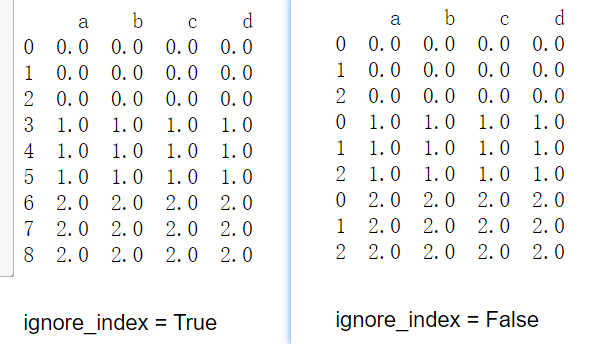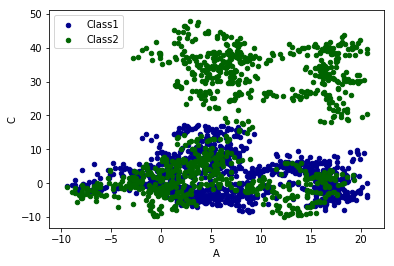1 Series
1.1 Preparation
- Import modules
1
2import pandas as pd
import numpy as np
1.2 Different data type
-
Time type
1
2
3t = pd.Timestamp('20180901') # time type
t
Timestamp('2018-09-01 00:00:00')Created by means of
data_range.1
2
3
4
5dates = pd.date_range('20200101', periods = 6)
dates
DatetimeIndex(['2020-01-01', '2020-01-02', '2020-01-03',
'2020-01-04','2020-01-05', '2020-01-06'],
dtype='datetime64[ns]', freq='D')
1.3 Create DataFrame
-
By dict
1
2
3
4
5
6
7# create a dataframe based on dict
df3 = pd.DataFrame({'A':1., 'B':pd.Timestamp('20160901'),
'C':pd.Series(1,index=list(range(4)),dtype='float32'),
'D':np.array([3]*4, dtype ='int32'),
'E':pd.Categorical(['test','train','test','train']),
'F':'foo'})
print(df3)Result:
1
2
3
4
5A B C D E F
0 1.0 2016-09-01 1.0 3 test foo
1 1.0 2016-09-01 1.0 3 train foo
2 1.0 2016-09-01 1.0 3 test foo
3 1.0 2016-09-01 1.0 3 train foo -
By Series
1
2
3# np.nan means NaN
s = pd.Series([1, 3, 5, np.nan, 44, 1])
print(s)Result:
1
2
3
4
5
6
70 1.0
1 3.0
2 5.0
3 NaN
4 44.0
5 1.0
dtype: float64 -
By np.array
1
2
3
4# create a dataframe based on imported array
df0 = pd.DataFrame(np.random.randn(6,4), index = dates, columns = ['a', 'b', 'c', 'd'])
df1 = pd.DataFrame(np.arange(12).reshape(3,4))
print(df1, df3, sep = '\n')
1.4 Basic information
1 | df3 = pd.DataFrame({'A':1., 'B':pd.Timestamp('20160901'), |
-
Dtype of each dimensional
1
df3.dtypes # dimensional type
-
Row and column index
1
2df3.index # row index name
df3.columns # column name -
Statistical description
Describe numerical characteristics, including count, mean, std, min etc.
1
df3.describe() # describe numerical characteristics, including count, mean, std, min etc.
Result:
1
2
3
4
5
6
7
8
9A C D
count 4.0 4.0 4.0
mean 1.0 1.0 3.0
std 0.0 0.0 0.0
min 1.0 1.0 3.0
25% 1.0 1.0 3.0
50% 1.0 1.0 3.0
75% 1.0 1.0 3.0
max 1.0 1.0 3.0 -
information
1
df3.info()
Result:
1
2
3
4
5
6
7
8
9
10
11
12
13<class 'pandas.core.frame.DataFrame'>
Int64Index: 4 entries, 0 to 3
Data columns (total 6 columns):
# Column Non-Null Count Dtype
--- ------ -------------- -----
0 A 4 non-null float64
1 B 4 non-null datetime64[ns]
2 C 4 non-null float32
3 D 4 non-null int32
4 E 4 non-null category
5 F 4 non-null object
dtypes: category(1), datetime64[ns](1), float32(1), float64(1), int32(1), object(1)
memory usage: 288.0+ bytes
1.5 Data type
-
Specifies the type when creation
1
2
3
4import pandas as pd
dfx = pd.DataFrame([['11', 1.2, 3], ['22', 4.8, 5],],
columns = list('abc'), dtype = np.object)
dfx.dtypesResult:
1
2
3
4a object
b object
c object
dtype: object -
Coercion
df.astype()1
2dfx[['a', 'b', 'c']] = dfx[['a', 'b', 'c']].astype('float'))
dfx.dtypesResult:
1
2
3
4a float64
b float64
c float64
dtype: object -
Turn into numeric
pd.to_numeric()1
2
3
4dfy = pd.DataFrame([['11', 1.2, 3], ['22', 4.8, '?'], ],
columns = list('abc'), dtype = np.object)
dfy['a'] = pd.to_numeric(dfy['a'])
print(dfy.dtypes)Use
pd.applyto apply it to the entire dataframe.1
2
3
4
5
6
7dfy1 = dfy.apply(pd.to_numeric, errors = 'ignore')
# Igonre and don't change this column when meet errors,
dfy2 = dfy.apply(pd.to_numeric, errors = 'coerce')
# Transfer the value into NaN when meet errors.
print(dfy.dtypes)
print('-------------------------')
print(dfy2)Result:
1
2
3
4
5
6
7
8a int64
b float64
c float64
dtype: object
-------------------------
a b c
0 11 1.2 3.0
1 22 4.8 NaN
2 Choose data
2.1 Basic operation
-
Import modules and generate datas
1
2
3
4
5
6
7
8import pandas as pd
import numpy as np
df = pd.DataFrame({'A':1., 'B':pd.Timestamp('20160901'),
'C':pd.Series(1,index=list(arange(4)),dtype='float32'),
'D':np.array([3]*4, dtype ='int32'),
'E':pd.Categorical(['test','train','test','train']),
'F':'foo'}) -
Row operation
1
2df2 = df[0:3] # row operation, 0-3 row
df2_1 = df[0:1] # single row -
Column operation
1
2df1 = df.A # same sa df.['A']
df2_2 = df['A'] # single column
2.2 Index methods
-
locSelect datas by label based index.
1
2# select by label based index: loc
df3 = df.loc[1] # the second row -
ilocSelect datas by postitional index.
1
2# selct by postitional index: iloc
df4 = df.iloc[:,1:3] # 1-3 column -
ixSelect datas by mixed selection.
1
2# mixed selection: ix
df5 = df.ix[:2,['A', 'D']] # deprecated
2.3 Conditional operation
- Logic expression
1
df6 = df[df['A'] > 4]
df['A'] > 4return the row index which number is bigger than 4, let me name this index asiRow, thendf[iRow]return the row date that meets above filter condition.
2.4 Functional methods
tail
df.tail(n)returns lastnrows from the DataFrame object based on position. It is useful for quickly verifying data. For negative values ofn, it returns all rows except the firstnrows, equivalent todf[n:].1
2
3df.tail() # Default n is 5
df.tail(3) # Return last 3 rows
df.tail(-5) # Return all rows except the first 5 row.
3 DataFrame operation
- Preparation
1 | import pandas as pd |
3.1 Value operation
-
Set value
Pay attention to the difference.
1
2
3
4df.iloc[2, 2] = 111
df.loc[0,'B'] = pd.Timestamp('20180901')
# Note: below command will create a new column named (0, 'B') which values are given
df[0,'B'] = pd.Timestamp('20180901') -
Change value
1
2df.iloc[2, 2] = 111
df.loc[0,'C'] = np.nan -
Fillna
1
2
3
4
5# Fill NaN, can't do it with df.fillna(0)
df['C'] = df['C'].fillna(0)
# maybe below command also can work?
df_1 = df.fillna(0) -
Dropna
1
2
3# Drop NaN
df.dropna(axis =0, how = 'any')
# how = ['any, 'all'], default is any
3.2 Advance operation
-
isnull
1
2df.isnull() # find which position is null, return a dataframe same size as df
np.any(df.isnull()) == True -
Transpose
1
2df.T
df.transpose() # transpose array -
Sort
1
2df.sort_index(axis = 1, ascending = False)
# horizontal descending sort
3.3 Delete values
Deleting one columns from DataFrame. Preparation:
1 | df = pd.DataFrame({'A':1., 'B':pd.Timestamp('20160901'), |
Representing:
1 | A B C D E F |
-
del1
del df['A'] # Delete A column from A, and A will change
Result:
1
2
3
4
5B C D E F
0 2016-09-01 1.0 3 test foo
1 2016-09-01 1.0 3 train foo
2 2016-09-01 1.0 3 test foo
3 2016-09-01 1.0 3 train foo -
drop
Adopting drop function, there are three equivalent expression.
直接输入 df.drop('column', 1),不会改变内存,再次输入 df 时,还是显示原数据。
1 | df = pd.DataFrame({'A':1., 'B':pd.Timestamp('20160901'), |
注:aixs = 1 表示该命令的操作聚焦于列这一维度。inplace 表示是否改变内存。默认为 False。
4 Merge dataframes
- Preparation
1
2
3
4
5
6
7import pandas as pd
import numpy as np
# 1 array multiply o is o
df1 = pd.DataFrame(np.ones((3, 4)) * 0, columns = ['a', 'b', 'c', 'd'])
df2 = pd.DataFrame(np.ones((3, 4)) * 1, columns = ['a', 'b', 'c', 'd'])
df3 = pd.DataFrame(np.ones((3, 4)) * 2, columns = ['a', 'b', 'c', 'd'])
4.1 Concatenation
1 | res = pd.concat([df1, df2, df3], axis = 0, ignore_index = True) # default don't ignore index, the difference seen in below pic |

-
join = [‘inner’, ‘outer’]
1
2
3
4
5
6
7
8
9
10
11
12
13import pandas as pd
import numpy as np
df1 = pd.DataFrame(np.ones((3, 4)) * 0, columns = ['a', 'b', 'c', 'd'], index = [1, 2, 3])
df2 = pd.DataFrame(np.ones((3, 4)) * 1, columns = ['b', 'c', 'd', 'e'], index = [0, 1, 2])
# default join is outer, fill the null space with NaN
df3 = pd.concat([df1, df2], axis = 0, join = 'outer', sort=False, ignore_index = True)
# inner will take the intersection index of two arrays
df4 = pd.concat([df1, df2], axis = 0, join = 'inner', sort=False, ignore_index = True)
# 将 df2 合并到 df1,并基于 index 去掉 df2 中有而 df1 没有的数据, 并填充 NaN
df5 = pd.concat([df1, df2], axis = 1, join_axes = [df1.index])
4.2 append
1 | import pandas as pd |
4.3 merge
-
merged by single key
1
2
3
4
5
6
7
8import pandas as pd
import numpy as np
left = pd.DataFrame({'key': ['K0', 'K1', 'K2', 'K3'],'A': ['A0', 'A1', 'A2', 'A3'],'B': ['B0', 'B1', 'B2', 'B3']})
right = pd.DataFrame({'key': ['K0', 'K1', 'K2', 'K3'],'C': ['C0', 'C1', 'C2', 'C3'],'D': ['D0', 'D1', 'D2', 'D3']})
# merge two dfs based on the same key value
res = pd.merge(left, right, on = 'key') -
merged by multiple keys
1
2
3
4
5
6
7
8
9
10import pandas as pd
import numpy as np
left = pd.DataFrame({'key1': ['K0', 'K0', 'K1', 'K2'],'key2': ['K0', 'K1', 'K0', 'K1'],'A': ['A0', 'A1', 'A2', 'A3'],'B': ['B0', 'B1', 'B2', 'B3']})
right = pd.DataFrame({'key1': ['K0', 'K1', 'K1', 'K2'],'key2': ['K0', 'K1', 'K0', 'K0'],'C': ['C0', 'C1', 'C2', 'C3'],'D': ['D0', 'D1', 'D2', 'D3']})
# merge two dfs based the same key value, default how = inner
res1 = pd.merge(left, right, on = ['key1','key2'])
res2 = pd.merge(left, right, on = ['key1','key2'], how = 'inner')
res2 = pd.merge(left, right, on = ['key1','key2'], indicator = True)how = ['inner, 'outer','left','right'], ifhow = 'right', this operation will fill left void space with NaN when left haven’t same key value with right, then merge into right.default
indicatorisFalse, this parameter will create a new column named _merge(indicator = ‘indicator_column’, then the new column’s name is indicator_column), which show if both arrays have a meanful value. -
merged by index
1
2
3
4
5
6
7
8
9
10import pandas as pd
import numpy as np
left = pd.DataFrame({'A': ['A0', 'A1', 'A2', 'A3'],'B': ['B0', 'B1', 'B2', 'B3']}, index = ['K0', 'K1', 'K2','K4'])
right = pd.DataFrame({'C': ['C0', 'C1', 'C2', 'C3'],'D': ['D0', 'D1', 'D2', 'D3']}, index = ['K0', 'K1', 'K3','K5'])
print(left, right, sep = '\n')
# left_index and right_index
res1 = pd.merge(left, right, left_index = True, right_index = True, how = 'inner') # based on left_index = right_index
res2 = pd.merge(left, right, left_index = True, right_index = True, how = 'outer') # fill the blank with NaN -
suffixes para
1
2
3
4
5
6
7
8
9import pandas as pd
import numpy as np
boys = pd.DataFrame({'K': ['K0', 'K1', 'K2','K4'],'age': [11, 23, 32, 12]})
girls = pd.DataFrame({'K': ['K0', 'K1', 'K2','K4'],'age': [14, 43, 12, 22]})
# suffixex means the named methods of same positional column
res = pd.merge(boys, girls, on = 'K', suffixes = ['_boys', '_girls'], how = 'inner')
print(res) # age_boys age_girls
5 Read and save file
1 | import pandas as pd |
6 matplotlib
1 | import numpy as np |
-
plot methods
bar, hist, box, kde, area, scatter, hexbin, pie
1
2
3
4
5
6
7
8
9
10import numpy as np
import pandas as pd
import matplotlib.pyplot as plt
data = pd.DataFrame(np.random.randn(1000, 4), index = np.arange(1000), columns = list('ABCD'))
data = data.cumsum()
ax = data.plot.scatter(x = 'A', y = 'B',color = 'DarkBlue', label = 'Class1')
data.plot.scatter(x = 'A', y = 'C',color = 'DarkGreen',label = 'Class2',ax = ax)
plt.show()Result:

fig. 2 scatter figure
